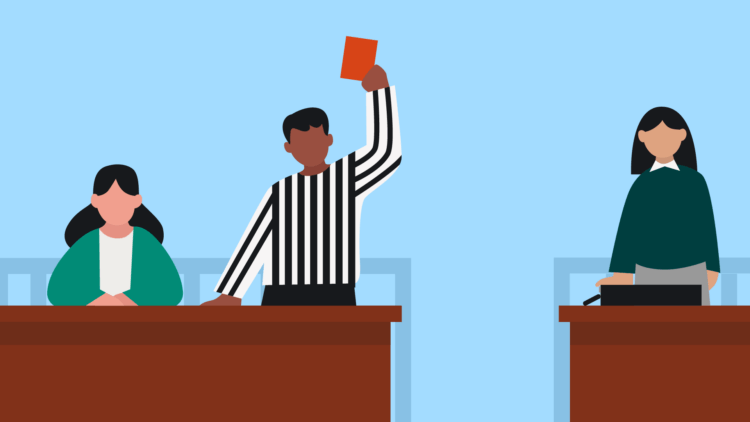Understanding the intricacies of a motion hearing can set you apart as a skilled attorney in the courtroom. These pivotal moments, where attorneys present targeted arguments before a judge, have the power to significantly shape the trajectory of a case. From striving to dismiss a case and advocating for critical evidence to securing preliminary rulings, excelling in motion hearings is essential for impactful legal practice.
In this blog, we explore the importance of these hearings and offer insights to help lawyers navigate them with confidence and precision.
(And, to create templates to make drafting motions easier, use Clio Draft to convert your Word docs into dynamic legal templates and cut time spent on routine legal drafting by 80%! Request a demo to see how it works.)
What is the purpose of a motion?
The purpose of a motion is to request a court ruling on specific legal or procedural issues, such as dismissing a case, delaying a trial, excluding evidence, or seeking a new trial. Motions help manage the trial process and ensure fairness and proper legal proceedings.
Understanding motion hearings
Motion hearings can range from requests to dismiss the case, compel discovery, or grant summary judgment—among many other things. The purpose of a motion hearing is to resolve these issues before the case proceeds further, ensuring that the parties are able to prepare for trial (or, in some cases, have the case resolved or dismissed before it gets to a trial).
Motion hearings play a strategic role in the litigation process. They occur at various stages, with pre-trial, mid-trial, and post-trial filings. For instance, a motion to dismiss might be filed at the beginning to challenge the legal basis of the case. Later in the process, a motion for summary judgment could seek to resolve the case without a trial by arguing that there are no material facts in dispute. And even after a trial, there can be filings such as a motion for a new trial. These hearings help streamline the case, clarify the issues, and can even lead to an early resolution.
In a motion hearing, several key players may participate, including the judge, attorneys, and clients. The judge, as the central figure, listens to the arguments, asks questions, and ultimately decides whether to grant or deny the motion. Attorneys for both parties present their arguments and counterarguments, aiming to persuade the judge in their favor. While clients typically do not speak during these hearings, their interests and outcomes are directly impacted by the judge’s ruling.
Keep in mind that not every motion will require a hearing. In some cases, the court may be able to make a determination based on written submissions alone, with no need for a courtroom hearing.
By mastering the intricacies of motion hearings, lawyers can influence the direction of the case, resolve critical issues early on, and ensure that key milestones run smoothly.
Navigating the motion hearing process

Motion hearings occur in person at the courthouse or can be done via virtual hearings. During the hearing, all parties involved in the case have an opportunity to present their arguments and evidence to a judge concerning a particular motion that has been filed.
The process typically begins with the judge or court clerk calling the case and identifying the parties involved, including attorneys and any self-represented individuals. The party who filed the motion, often known as the “movant,” presents their arguments first. The movant will outline the legal basis for the motion, reference relevant laws or precedents, and present any supporting evidence or documents to bolster their position.
Following the movant’s presentation, the opposing party is given the opportunity to respond. They will offer counterarguments, present contrary evidence, and highlight any legal reasons why the motion should not be granted. Throughout this exchange, the judge may interject with questions to clarify points made by either side.
After both parties have presented their arguments and evidence, the movant may be allowed a brief rebuttal to address any points raised by the opposing party.
Once all arguments have been heard and considered, the judge will make a decision.
The outcome of the motion hearing
Depending on the complexity of the motion and the judge’s preferences, this decision may be made immediately from the bench or taken under advisement for a later ruling.
The judge’s decision is issued in the form of an order, which grants or denies the motion. This order becomes an official part of the court record and dictates the next steps in the litigation process. The outcome of a motion hearing can have significant implications for the case, as it may determine what evidence will be admissible, what legal standards will apply, or even whether the case will proceed to trial.
What does it mean when motion is granted?
When a motion is granted, it means the court has approved the request made by one of the parties involved in the case, often leading to significant implications for the outcome of the legal proceedings.
What does it mean when motion is denied?
When a motion is denied, it means the court has rejected the request made in the motion, finding it lacks sufficient merit or legal basis. This decision prevents the requested action or ruling from being implemented in the case.
Common motions in litigation
In litigation, several key motions can shape the direction of a case:
- Motion to Dismiss: Request to terminate the case on legal grounds, such as lack of jurisdiction or failure to state a claim.
- Motion to Suppress: A legal document filed by the defense in criminal cases seeking to exclude certain evidence from being presented at trial.
- Motion for Summary Judgment: Seeks a ruling in favor of the moving party without a trial, arguing there are no disputed material facts.
- Motion to Compel: Asks the court to order the opposing party to provide requested evidence or information.
- Motion for a Preliminary Injunction: Requests temporary relief to maintain the status quo until the case is decided.
- Motion in Limine: Aims to exclude certain evidence from being presented at trial.
- Most of a New Trial: A request made after a verdict, asking the court to invalidate the original trial’s outcome and hold a new trial.
- Motion for Change of Venue: Request to have a case is transferred from one court jurisdiction to another to ensure a fair trial and avoid bias or undue influence.
The above list is just a preview of the many types of motions that can affect a case’s outcome. Be sure to do your research and ensure that you understand the types of motions, when to file them, and what strategy would be best for your desired outcome.
Is a motion the same as a hearing?
No, a motion is a formal request to the court, while a hearing is the proceeding where the court considers and decides on that request.
What does a motion mean in a hearing?
A motion is a formal request made to the court by one of the parties involved in the case, asking the judge to issue a ruling or order on a specific legal or procedural matter.
You may like these posts
10 steps to take when preparing for a motion hearing
Adequate preparation enables lawyers to understand the legal issues at hand thoroughly, gather relevant evidence, craft persuasive arguments, and anticipate potential challenges from opposing counsel. By being well-prepared, you can present your case confidently, increase your credibility with the court, and maximize the chances of achieving a favorable outcome for your clients.
Additionally, thorough preparation can help lawyers navigate complex legal procedures and ensure compliance with court rules and deadlines, reducing the risk of procedural errors that could adversely impact the case.
Here’s a step-by-step guide for lawyers to effectively prepare for a motion:
- Understand the motion: Begin by thoroughly reviewing the motion filed by opposing counsel. Analyze the legal arguments, supporting evidence, and any relevant case law cited.
- Legal research: Conduct comprehensive legal research to understand the applicable statutes, regulations, and case precedents relevant to the motion. Identify key legal principles and precedents that support your arguments.
- Gather evidence: Collect all relevant evidence, exhibits, affidavits, and documents that support your position on the motion. Ensure that your evidence is admissible and properly authenticated.
- Draft legal briefs: Prepare clear, concise, and persuasive legal briefs outlining your arguments. Organize your briefs logically, addressing each legal issue raised by the motion and citing relevant legal authority.
- Prepare witnesses: If witness testimony is necessary, thoroughly prepare your witnesses for examination. Anticipate potential questions and objections, and ensure that your witnesses are credible and articulate.
- Practice oral arguments: Rehearse your oral arguments before the hearing to ensure clarity, coherence, and persuasiveness. Anticipate questions from the judge and opposing counsel, and prepare concise responses.
- Review court procedures: Familiarize yourself with the local court rules and procedures governing motion hearings. Understand the timeline for filing motions, submitting evidence, and presenting arguments.
- Courtroom etiquette: Dress professionally and arrive early on the day of the hearing. Follow courtroom etiquette, address the judge respectfully as “Your Honor,” and adhere to procedural rules and decorum.
- Prepare for possible outcomes: Consider the potential outcomes of the motion hearing and develop contingency plans accordingly. Evaluate the strengths and weaknesses of your case, and be prepared to adapt your strategy as needed.
- Consult with colleagues: Seek input from colleagues or mentors who have experience with similar motions. Collaborate with other legal professionals to refine your arguments and address any potential challenges.
By following these steps and dedicating sufficient time and effort to preparation, lawyers can effectively advocate for their client’s interests and increase their chances of success in a motion hearing.
Final thoughts on motion hearings
Motion hearings serve as critical junctures in the legal process, allowing parties to address both procedural and substantive matters before trial. By narrowing the scope of disputes and enhancing judicial efficiency, they play a pivotal role in conserving valuable time and resources for all involved.
This streamlined approach not only expedites case resolution but also enables legal professionals to allocate their expertise more effectively, ultimately fostering a fairer and more accessible justice system for all.
If you’re an attorney who often heads to court and is constantly filing different motions, check out how Clio can help. With document automation, templates, and a court forms library for all 50 states, Clio Draft helps law firms save time drafting documents. And with Clio File, you can easily e-file and serve your motions to the court, ensuring timely filings. Book your demo today to learn more!
We published this blog post in June 2024. Last updated: .
Categorized in: Uncategorized
See how Clio can help your law firm processes
Learn how firms level up their business with Clio.
See Clio in Action







